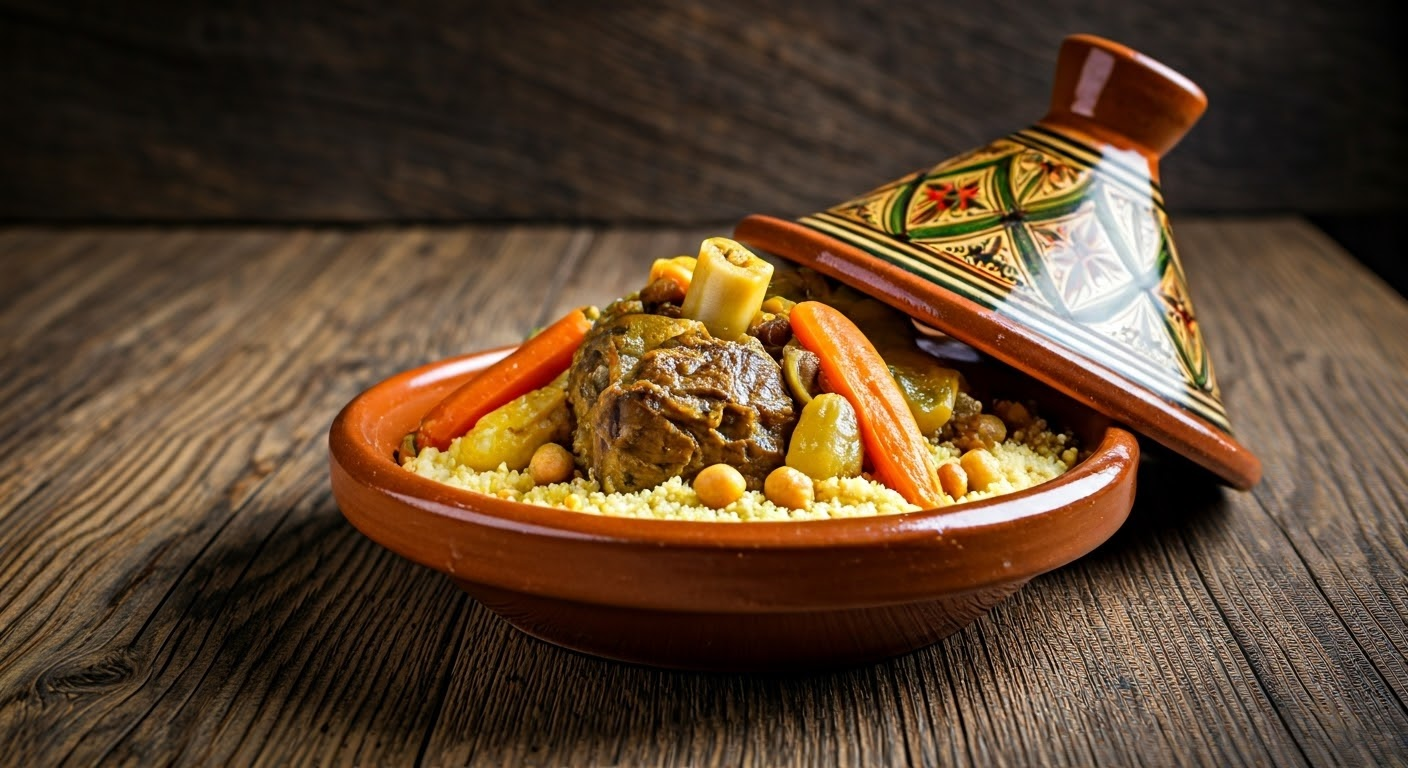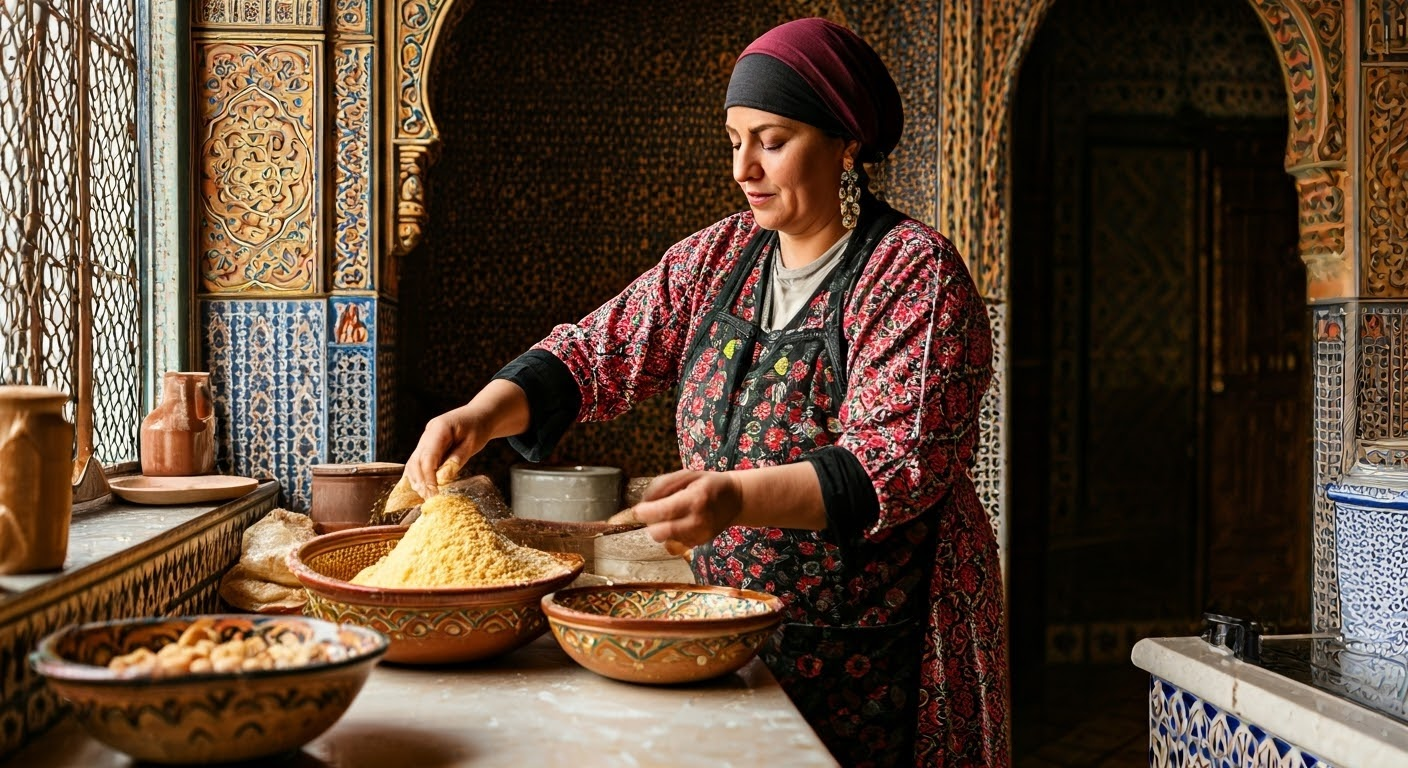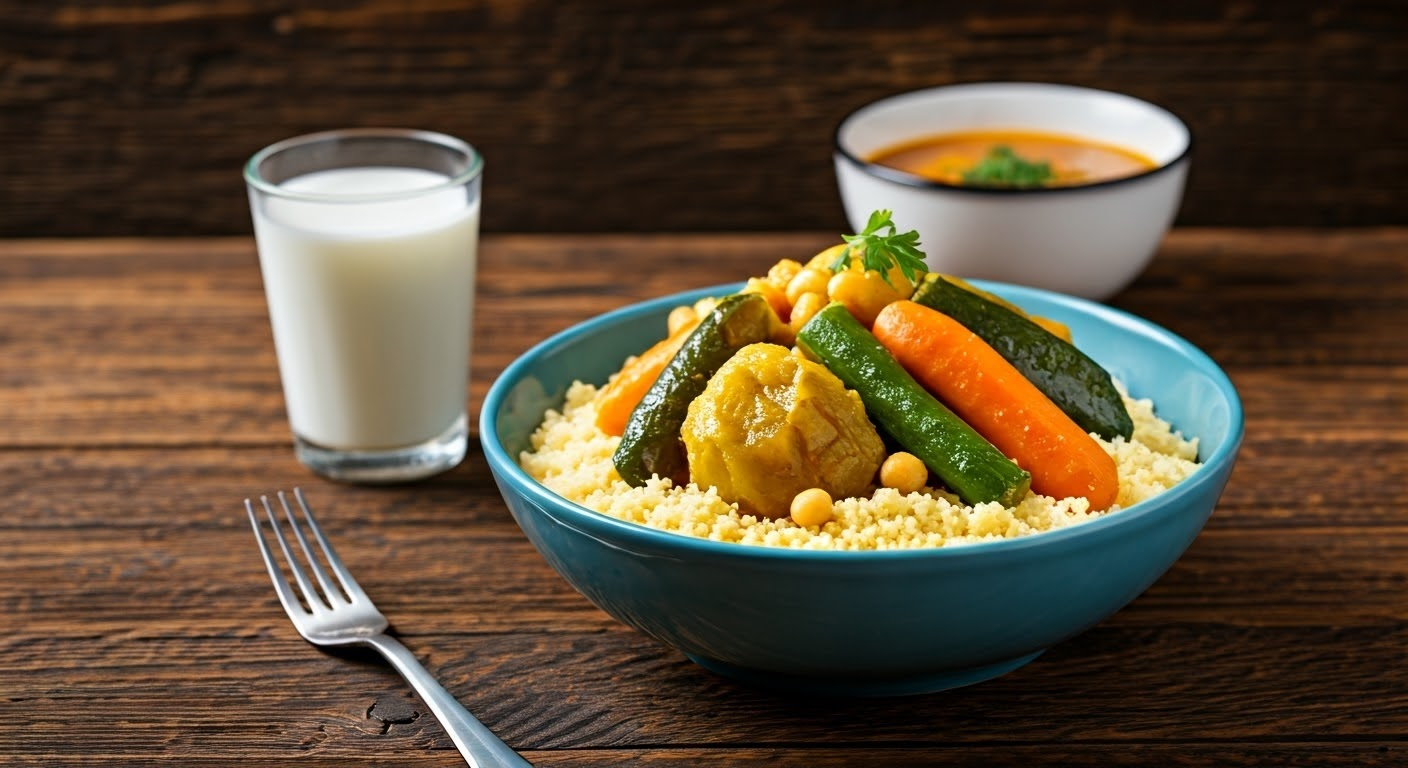Indulge in the authentic flavors of Moroccan couscous with our traditional recipe. Experience a taste of tradition on our blog!

Couscous: The Dish That Binds Us Together
In Morocco, we say, “Couscous is the dish that gathers.” This means that couscous is not just food. It stands for a ritual and a tradition. It is a way to show love that has been shared for many years.
I always think back to Fridays from my childhood. When the prayer call echoed in Casablanca, our home smelled amazing. It was filled with the scent of slow-cooked lamb and many spices. My mother stood by the kitchen holding the Keskas (our traditional couscous cooker), with steam rising as she patted the grains with her hands. This method was passed to her from her mom, who inherited it from her previous generation as well.
A Friday Ritual, A National Treasure
For us Moroccans, Friday is a special day for couscous. Families gather, neighbors share their plates, and everyone can join. UNESCO has not recognized couscous as more than just food in vain; they have considered it an intangible cultural heritage, which it truly deserves. The uniqueness of our couscous comes from more than just the ingredients. It’s also about the patience, the stories, and the people who make it.
Some people believe couscous is just tiny pasta. However, real Moroccan couscous is genuinely an art. The semolina is steamed three times, and each time it’s steamed, it becomes lighter and fluffier. The broth cooks slowly with lamb, chicken, fish, carrots, zucchini, and spices like turmeric, ginger, and a little Ras el Hanout. To top it off, a drizzle of Smen (fermented butter) adds a rich, unforgettable flavor.
The Historical Significance of Couscous in Moroccan Cuisine
Moroccan couscous is more than just a meal; it is a dish that connects people. Making authentic Couscous goes beyond cooking; it is a tradition of love passed down through generations. We steam the grains in the Keskas and mix in several spices to create great flavors. Each step reflects our connection to our culture and history. Enjoying and sharing couscous is more than just eating. It is an experience that brings us closer together.
As time passed, couscous became our country’s number one meal. The whole family participates when we cook couscous, especially for special occasions. This practice helps bring families closer together to share cooking skills between generations. The way we carefully steam couscous, usually in a pot called a Keskas, shows the love and effort we put into making this popular dish.
Today, Moroccan couscous is very important in the country’s food culture. A dish known as pearl is especially tasty. Families love to eat it. You can also find this dish in restaurants around the globe.
The Art of Preparing Traditional Moroccan Couscous
Traditional ways to make couscous involve steaming it several times to get a fluffy texture. Instant couscous is becoming popular because it cooks quickly. However, if you want to enjoy the authentic flavor of Moroccan couscous, I advise you to try the traditional way. They have a special texture that makes them stand out.
Making real Moroccan couscous requires skill. You need to pick good ingredients and use classic cooking methods. The quality of the semolina flour matters a lot. The kinds of spices you use are also important. Each part helps to create the delicious flavor of the dish.
Now, let’s look at how to make this classic dish. We will ensure that each grain is fluffy and captures the true flavors of Moroccan food.
Selecting the Right Ingredients for Authentic Flavor
Next, decide what kind of fat you want to use. Many people pick vegetable oil, but extra virgin olive oil can add more flavor and improve your dish. The broth is important, too. A great choice is tasty homemade chicken broth or a quality store-bought one. This gives your couscous a rich and savory taste. Spices play a key role in Moroccan cooking. Use warming spices like cumin, ginger, and turmeric in your couscous.
Step-by-Step Guide to Making Couscous the Moroccan Way
- Preparing the Couscous: Start by adding a small amount of olive oil to the couscous. Rub the grains gently between your hands. This prevents the grains from sticking and helps them soak up moisture while steaming. Gradually pour warm water or broth into the couscous. After each pour, use a fork to fluff it.
- Steaming: Couscous is usually steamed several times in a Kaskas, which is a special pot with a steamer basket. If you don’t have one, you can use a regular steamer basket on top of a pot with simmering broth. Spread the couscous out evenly in the basket, so the grains do not touch the water below. Cover the basket and steam over medium heat for 15 to 20 minutes each time.
- Fluffing: After each steaming, move the couscous to a wide, shallow dish. Use a fork to fluff the grains gently. This step keeps the grains apart and lets extra steam escape. Fluffing is important to make the couscous light and airy.

The Role of Vegetables in Enhancing Couscous Dishes
Moroccan cooks skillfully mix vegetables with flavorful spices and rich broths. This mix brings out delicious tastes that go well with the mild flavor of couscous.
Common Vegetables Used in Moroccan Couscous
Zucchini and eggplant have light flavors. They soak up spices very well, which enhances the dish’s flavor. Leafy greens like cabbage and spinach bring a fresh taste. They also change the texture in a nice way.
Tomatoes, onions, and bell peppers are popular choices that make a tasty base for this dish. A wonderful thing about Moroccan couscous is that you can mix things up. You can experiment with different vegetable combinations to make your own special recipe.
Tips for Perfectly Blending Spices and Vegetables
- Toast Your Spices: Toast your spices in a dry pan on low heat for a little while. This makes their flavor stronger. It helps to release their oils, making them smell and taste better.
- Layer Your Flavors: Begin by cooking onions, garlic, and ginger to create a good base. Next, add spices like cumin, coriander, and turmeric. Cook them for one or two minutes to bring out their nice smell.
- Don’t Overcook Vegetables: Add your vegetables at different times based on how long they need to cook. This way, each one stays fresh and colorful. Start with harder root vegetables, and add leafy greens toward the end.
Serving and Enjoying Moroccan Couscous
The light couscous works well as a base for soft meat, if you want to add some, and a mix of colorful vegetables. This dish helps bring guests together to enjoy the delicious food made in the kitchen.
Traditional Moroccan Serving Methods
Tender lamb or chicken rests on top of couscous. A mix of bright vegetables surrounds the meat. A little fresh parsley adds color, and flavorful broth makes the dish even tastier.
Moroccans love to eat Couscous together. They share a big dish and take some for their plates. This time is perfect for family and friends to connect and enjoy this traditional meal.
Pairing Couscous with Other Moroccan Dishes
Another good option is to have couscous with Moroccan Harira soup. This hearty tomato soup is well-liked during Ramadan. The soft and fluffy couscous tastes great with the soup’s rich flavor. Don’t forget to have a glass of fresh Laban, a drink from fermented milk. It makes a wonderful meal.

Conclusion
Moroccan couscous is more than just food; it is part of our culture. This dish brings together history and great flavors. To create authentic Moroccan couscous, choose your ingredients and spices carefully. These elements come together to create a tasty and fragrant meal. When you learn how to prepare this dish, you dive into Moroccan culture. By mastering traditional cooking methods, you can make your meals memorable. Allow Morocco’s bright colors and rich tastes to shine in your kitchen. Enjoy a classic taste that you will remember forever!
Frequently Asked Questions
What Makes Moroccan Couscous Different from Other Types?
Moroccan couscous is special because it uses fine semolina flour. This flour is usually steamed. This process makes it feel light and fluffy. It also includes tasty broths, a mix of aromatic spices, and different vegetables. These ingredients make it different from other types of couscous. It offers a unique and enjoyable meal.
Couscous is more than just a meal. It carries memories. It shows who we are. It brings the feel of home, no matter where you are in the world.
I want to know, what’s your best couscous memory? Do you have a family recipe that’s special to you? Please share your stories below. I would really love to hear what you have!
Sent with love from Morocco, where every Friday is filled with the smell of cumin and saffron. It feels like home. 🇲🇦❤️
